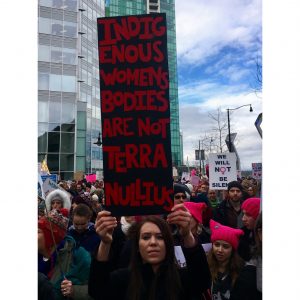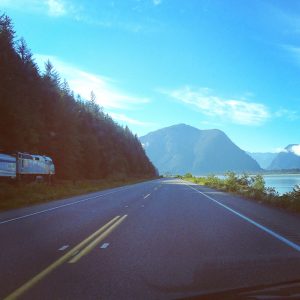To position my work, you may find my self-location here.
Transcription of the podcast with references
—————————————————————–
Hello, and welcome to my third (and final!) blog of the semester for the course First Nations and Indigenous Studies #401F! My name is Lisa Girbav, and I am an urban Tsimshian student in my third year at UBC. I grew up back home, in my territory, in city of Prince Rupert, and the Tsimshian territory is situated on the northwest coast, around the mouth of the Skeena River, which is east of Haida Gwaii on the mainland, and near the southern tip of Alaska. So that’s who I am. And at this point in my life, I live, work and study as an uninvited guest on the traditional, ancestral and unceded lands of the Musqueam, Squamish and Tsleil-Waututh peoples… and for this I am very grateful.
This blog is called Podcasting an Indigenous Future(ism) – Métis in Space. And when I threw this title together, I thought, “do we really need the ‘ism’ here? Would it still work if I left it open ended and called it Podcasting an Indigenous Future?” But this is an assignment on Indigenous futurism… as a fictional, critical and/or creative representation of an Indigenous future. So there you go.
The reason I decided to make a podcast for this blog is because I wanted to create something that would make this academic work accessible to a wide audience. Academic work can often have a lot of jargon, and I know that when I read dense stuff I tend to zone out (a.k.a. all of my academic life), but when someone is telling me information verbally, it’s a way different experience, and a different way of understanding things. That’s how I comprehend the best, anyway. And another reason I decided on a podcast format is because I know I don’t have a lot of time to read a 1500 word blog post everyday among the many other readings I have to do for school… but I can listen to a podcast on the bus without making myself feel sick.
For this podcast, I aim to look at how the Indian and Cowboy podcast Métis in Space has effectively created a sovereign Métis space on the Internet, while actively challenging colonial perceptions in the science fiction genre and imagining original Indigenous futurisms. Grace Dillon describes Indigenous futurism as, quote, “a growing movement of writing, both fictional and critical, that envisions the future from the point of view of Indigenous histories, traditions, and knowledges,” end quote (as cited in Gaertner, 2014). For the purpose of this blog, I will focus on the episode Métis in Space Season 2 Episode 3 – Futurama “Where The Buggalo Roam” (Indian and Cowboy, 2015).
[CLIP 1] “Otipêyimsiw-iskwêwak kihci-kîsikohk, Métis in Space. Alright so, um anyway, yeah um episode. Yeah we went really far into the future with this one, father into the future than we have ever been. Exactly” (Indian and Cowboy, 2015, 4:48-5:06)
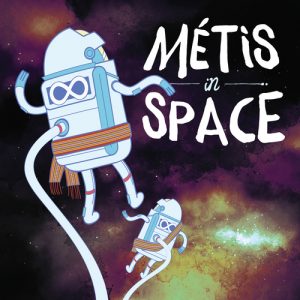
Metis in Space is co-hosted by Molly Swain who is Métis from Calgary, Alberta, and Chelsea Vowel who is Métis from the Plains Cree and Michif speaking community of Lac Ste. Anne, Alberta. The two hosts have created a unique multi-platform online space, that discusses a science fiction movie or television episode that features, quote, “Indigenous peoples, tropes and themes” from a “tipsy decolonial perspective,” end quote (Metis in Space, About, para 1).
The opening line of the article Aboriginal Territories in Cyberspace by Jason Lewis & Skawennati Tricia Fragnito (2005) states quote, “Indigenous peoples are making their own spaces online, using art as the backdrop for cross cultural dialogue.” end quote (Introduction section, para. 1). Métis in Space has created an Indigenous space online, with the opportunity for cross-cultural dialogue rooted in a decolonial perspective. The website is a Métis defined space, where the user must cross the initial threshold to enter “their” site from the home page, which I argue signifies a sovereign controlled Métis cyberspace. As Lewis and Skawennati (2005) describe, the Internet can be quote, “a valuable tool for community-building.” end quote (Learning from CyberPowWow, para 2). The hosts are readily accessible to their audience via their website, email and through Twitter, where both Twitter handles for Molly and Chelsea are linked to their bios. This provides an invitation for the audience to engage with the hosts, on the hosts’ terms, before the podcast even begins. Throughout the podcast they consistently encourage their audience to engage with the show.
In Season 2 Episode 3 “Where the Buggalo Roam” the hosts offer entry points for Indigenous and settler people to enter the conversation. While I think that the target audience for Métis in Space is meant to be an Indigenous audience (there are often references that are not made explicit), I believe the concepts discussed in the show are primarily targeted for an academic audience – narrowing the accessibility. However, the hosts are able to make the topics accessible by presenting these critiques with humor, through oral storytelling, and this makes it more accessible for listeners to engage with the dialogue–regardless of Indigeneity or educational background. In one example, Molly and Chelsea open the door for a critique of Futurama’s use of satire, making it relatable to all their audience members.
[CLIP 2] “Satire is tough right because like you, if you’re just replicating sort of oppressive ideas and stereotypes and stuff like that, that’s not satire that’s just how shit is, right? And sometimes Futurama gets it right and really like makes fun of it in such an obvious way that it’s cringe, you know … you’re supposed to cringe at satire and be like oh my gosh that’s so terrible, that’s obviously wrong. But if you’re kinda like ‘hahaha yeah right’ that’s not satire.” (Indian and Cowboy, 2015, 6:51- 7:22)
They go on to address the inappropriate use of “Asian stereotypes” through their formula of what they qualify as satire versus racial stereotypes. Topics like these open the door for cross-cultural dialogue in a Métis defined space.
The podcast functions as a contemporary Indigenous critique on colonial representations of Indigenous people in the science fiction genre. This episode of Métis in Space effectively challenges how Futurama presents colonial perceptions of Indigenous culture. In the podcast, the hosts describe how the Native martians were “gently encouraged” to live in reservations deep underground (Indian and Cowboy, 2015, 26:27-26:44).
[CLIP 3] “The martians have no land, they were gently encouraged to live on reservations deep underground and no-one ever goes there. Yup. Gently encouraged. Reservations deep underground, which you know is where they would have fucking put us if they could. Yup. Out of sight, out of mind. Seriously.” (Indian and Cowboy, 2015, 26:27-26:44)
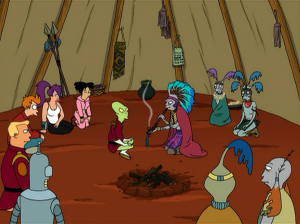
Groening, M. (Creator/writer) (2013). Where the buggalo roam [Television series episode]. Retrieved from Netflix, https://www.netflix.com/watch/70140734?trkid=13752289&tctx=0%252C0%252C1f13fd29054576d06144c17c919ef139ed7b93be%253A06449b0377000391f616679008fd000dc9946e9b
This reference to putting the Native martians on reservations deep underground is contextualized within the show and related back to the settler colonial state we exist in now. They draw direct connections between the context of the plot and the current settler state, not bothering to differentiate between fiction and reality, past, present or future. They frame the representation on the screen as being directly correlated with the current state, blurring the lines between fiction and real life/ IRL.
[CLIP 4] “They, yeah, they go into the entrance and… there’s this sign that says, uh, ‘Martian Reservation, trespassers will be guilt ridden.’ So ok, lets just look at that for a second… Basically there’s the idea that of course like, they have no power to do anything about people who trespass, right? For one thing, so there’s this powerlessness, but it’s also this idea of white guilt, right? Like, Native people make you feel guilty, and so when you’re dealing with Native people just be prepared to be guilt ridden.” (Indian and Cowboy, 2015, 29:12-30:33)
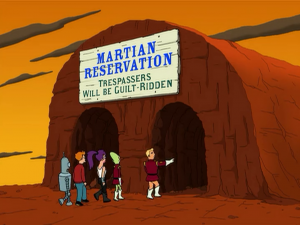
Here, Chelsea and Molly confront the narratives in Futurama, and elaborate on the misrepresentation of power differences in the relationship between the colonizer and the colonized, and bring in the concept of white guilt.
The critique on the Futurama episode by Métis in Space draws similarities between the science fiction narrative in this episode and colonial narratives IRL.
[CLIP 5] “It’s like they take all these narrative strains and layer them on top of each other. So it’s like, you know, Western movies, colonialism, masculinity, and then also of course like the science fiction is all happening kind of at once and like teasing these things apart is like really, really interesting. But it kind of goes to show that a lot of these things, you know, they put all this together and create a very recognizable coherent narrative.” (Indian and Cowboy, 2015, 27:59-28.33)
What I found interesting about this episode, is that Métis in Space not only critiques mainstream science fiction, but also incorporates original Indigenous futurisms within the context of the podcast. In this case, the hosts receive a transmission from the future, approximately 250 years in the future.
[CLIP 6] “Oh, wait! Hey, I think, are we getting a transmission? Oh, oh is that what that is? I heard something buzzing. Yeah, ok ok, lets… we’re going to have to take a pause here, lets get this in because we never know if we’re gonna get it again, so lets yeah hold on one sec…” “Dispatches from the future. Incoming, in three, two, one…” “So, as we, we set up here in orbit and kinda watch what’s, what’s going down, ahh, below us… ahh, we’re kind of seeing an interesting kind of situation play out…” (Indian and Cowboy, 2015, 37:20-37:50)
Molly and Chelsea envision themselves as characters in the future, that describe a future scenario from an Métis perspective. The transmission emphasizes the juxtaposition of their Métis perspective with a non-Métis perspective to relationship making. The future selves of Molly and Chelsea observe attempts to be Indigenous by claiming to be Métis, yet deny a relationship to one another. The hosts describe this as an attempt at a quote “colonial move to innocence,” and describe this as an “archaic twist on this worldview” end quote. In their representation of an Indigenous futurism, this settler move to innocence is framed as an antiquated practice.
[CLIP 7] “They had decided that they were Indigenous and that they had replaced the other Indigenous peoples so there, there were some pretty strong claims that they created their own communities and their federations and you know tribes and stuff like that, but now these people are saying “no we’re not related to you at all, thus we can’t have a relationship. Yeah, and of course, like, this is one of kind of those moves to innocence, those colonial moves to innocence that were really distorted during the … in like 2018-2021, so these, this is like, kind of a really, kind of like archaic twist on this world view. Ahh, it just seems strange that they haven’t moved past this.” (Indian and Cowboy, 2015, 40:07-40:45)
The Indigenous futurism Molly and Chelsea describe emphasizes the importance of an ongoing future framework that involves the continued relationship to land and one another. Nalo Hopkinson describes how people of colour take narratives in science fiction of quote, “colonizing the natives” and effectively “critique it, pervert it, fuck with it, with irony, with anger, with humor and also, with love and respect for the genre of science fiction that makes it possible to think about new ways of doing things.” end quote (as cited in Cornum, 2015, para. 2). I argue that Métis in Space does this effectively. As David Gaertner succinctly put it, Indigenous futurism can be described as, quote “imagining the future from an Indigenous perspective” that “projects Indigenous people into the future” end quote (personal communication, October 31, 2016).
[CLIP 8] “Métis in Space. Otipêyimsiw-iskwêwak kihci-kîsikohk, Métis in Space. (Indian and Cowboy, 2015, 108:10-108:27)
Métis in Space has created a sovereign digital Métis space through their website and social media platforms. It is my belief that Métis in Space speaks to a contemporary Indigenous critique on colonial representations of Indigenous people in science fiction, while offering an alternative representation of Indigenous futurism. Metis in Space challenges the production of the mainstream genre of science fiction by producing counter narratives in an accessible format for Indigenous and non-Indigenous people.
Thank you for listening! My name is Lisa Girbav and this is my podcast titled Podcasting an Indigenous Future(ism) – Métis in Space. And thank you to the hosts of Métis in Space for allowing me to use their audio for this podcast.
References:
Cornum, L. C. (2015). The space NDN’s star map. Retrieved from http://thenewinquiry.com/essays/the-space-ndns-star-map/
Gaertner, D. (2014). Traditional innovation: The turn to a decolonial new media studies. Retrieved from https://novelalliances.com/2014/11/25/traditional-innovation-the-turn-to-a-decolonial-new-media-studies/
Groening, M. (2013) [Where the buggalo roam]. From Futurama. Retrieved from https://www.netflix.com/watch/70140734?trkid=13752289&tctx=0%252C0%252C1f13fd29054576d06144c17c919ef139ed7b93be%253A06449b0377000391f616679008fd000dc9946e9b
Indian and Cowboy (2015). Otipêyimsiw-iskwêwak kihci-kîsikohk, Métis in Space (S.2) EP#3 – Futurama “Where The Buggalo Roam.” Retrieved November 12, 2016 from http://www.metisinspace.com/episodes/2016/4/2/mtis-in-space-s2-ep3-futurama-where-the-buggalo-roam
Indian and Cowboy (n.d.) [Métis in Space]. Retrieved from https://static1.squarespace.com/static/531df8c1e4b089910ebaf2fc/54177c62e4b06556b717752b/54205963e4b03f1e88166441/1419064268993/?format=500w
Lewis, J. & Fragnito, S. T. (2005). Aboriginal territories in cyber space. Cultural Survival, 29.2. Retrieved from https://www.culturalsurvival.org/publications/cultural-survival-quarterly/canada/aboriginal-territories-cyberspace
